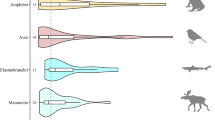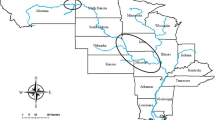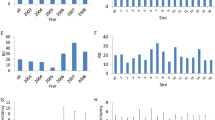Abstract
LIFE-HISTORY theory predicts that reduced adult survival will select for earlier maturation and increased reproductive effort; conversely, reduced juvenile survival will select the opposite1#150;5. This is supported by laboratory studies6–10 and comparative data from natural populations11–15. Laboratory studies may support a theory, but cannot assess its importance in natural populations, and comparative studies reveal correlations, not causation16. Long-term perturbation experiments on natural populations resolve both problems. Here we report the findings of a long-term study of guppies (Poecilia reticulata), in which the predictions of life-history theory are supported. Life-history differences among populations of guppies are closely associated with predator species with which guppies live13,17–21. The predators apparently alter age-specific survival because they are size-specific in their choice of prey21–23. Crenicichla alta (a cichlid), the main predator at one class of localities, preys predominantly on large, sexually mature size classes of guppies22–24. Rivulus hartii(a killifish), the main predator at another class of localities, preys predominantly on small, immature size classes. Guppies from localities with Crenicichla mature at an earlier age, have higher reproductive effort, and have more and smaller offspring per brood than those from localities with just Rivulus. These differences are heritable, and correspond with theoretical predictions17–19. To prove that predation caused this pattern, we perturbed a natural population of guppies by changing predation against adults to predation against juveniles. This resulted in significant life-history evolution in the predicted direction after 11 years, or 30–60 generations.
This is a preview of subscription content, access via your institution
Access options
Subscribe to this journal
Receive 51 print issues and online access
$199.00 per year
only $3.90 per issue
Buy this article
- Purchase on Springer Link
- Instant access to full article PDF
Prices may be subject to local taxes which are calculated during checkout
Similar content being viewed by others
References
Charlesworth, B. Evolution in Age Structured Populations (Cambridge University Press, New York, 1980).
Gadgil, M. & Bossert P. W. Am. Nat 104, 1–24 (1970).
Kozlowski, J. & Wiegert, R. G. Evol. Ecol. 1, 231–244 (1987).
Law, R. Am. Nat. 114, 399–417 (1979).
Michod, R. E. Am. Nat. 113, 531–550 (1979).
Luckinbill, L. S. & Clare, M. J. Heredity 55, 9–18 (1985).
Luckinbill, L. S. & Clare, M. J. Heredity 56, 329–335 (1986).
Mueller, L. D. & Ayala, F. D. Proc. natn. Acad. Sci. U.S.A. 78, 1303–1305 (1981).
Rose, M. R. Evolution 38, 1004–1010 (1984).
Rose, M. R. & Charlesworth, B. Genetics 97, 187–196 (1981).
Law, R., Bradshaw, A. D. & Putwain, P. D. Evolution 31, 233–246 (1977).
Leggett, W. C. & Carscadden, J. E. J. Fish. Res. Bd. Can. 35, 1469–1478 (1978).
Reznick, D. N. & Endler, J. E. Evolution 36, 160–177 (1982).
Stearns, S. C. Evolution 37, 601–617 (1983).
Tinkle, D. W. & Ballinger, R. E. Ecology 53, 570–585 (1972).
Endler, J. E. Natural Selection in the Wild (Princeton University Press, New Jersey, 1986).
Reznick, D. N. Evolution 36, 1236–1250 (1982).
Reznick, D. N. Am. Nat. 120, 181–188 (1982).
Reznick, D. N. Ecology 64, 862–873 (1983).
Reznick, D. N. Evolution 43, 1285–1297 (1989).
Reznick, D. N. & Bryga, H. Evolution 41, 1370–1385 (1987).
Liley, N. R. & Seghers, B. H. in Function and Evolution in Behavior (eds Baerends, G. P., Beer, C. & Manning, A.) 92–118 (Oxford university Press, 1975).
Endler, J. A. Evol. Biol. 11, 319–364 (1978).
Endler, J. A. Evolution 34, 76–91 (1980).
Mertz, D. B. Physiol. Zool. 48, 1–23 (1975).
Williams, G. C. Evolution 11, 398–411 (1957).
Brooks, J. L. & Dodson, S. I. Science 150, 28–35 (1965).
Hughes, R. N. & Seed, R. Mar. Ecol. (Progr. Ser.) 6, 83–89 (1981).
Schneider, D. C. Mar. Ecol. (Progr. Ser.) 5, 223 (1981).
Werner, E. E. & Hall, D. J. Ecology 55, 1042–1058 (1974).
SAS Institute, Inc. SAS User's Guide: Statistics (SAS Inst. Inc., Cary, North Carolina, 1985).
Author information
Authors and Affiliations
Rights and permissions
About this article
Cite this article
Reznick, D., Bryga, H. & Endler, J. Experimentally induced life-history evolution in a natural population. Nature 346, 357–359 (1990). https://doi.org/10.1038/346357a0
Received:
Accepted:
Issue Date:
DOI: https://doi.org/10.1038/346357a0
This article is cited by
-
Phylogeography and phenotypic wing shape variation in a damselfly across populations in Europe
BMC Ecology and Evolution (2024)
-
Shoaling guppies evade predation but have deadlier parasites
Nature Ecology & Evolution (2022)
-
On the genetic architecture of rapidly adapting and convergent life history traits in guppies
Heredity (2022)
-
Loss of transcriptional plasticity but sustained adaptive capacity after adaptation to global change conditions in a marine copepod
Nature Communications (2022)
-
Flocking in birds is associated with diet, foraging substrate, timing of activity, and life history
Behavioral Ecology and Sociobiology (2022)
Comments
By submitting a comment you agree to abide by our Terms and Community Guidelines. If you find something abusive or that does not comply with our terms or guidelines please flag it as inappropriate.



